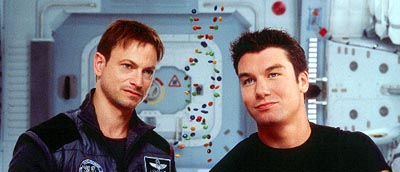Stupid Science: Can Moviemakers Ever Get It Right?
An Inconvenient Truth aside, science does not really figure into this year's Academy Awards, unless you also count the chemistry that sometimes bonds audience to actor or that builds among ensemble casts.
And maybe that's a relief. Science — separate from science fiction — does not usually fare well at the hands of moviemakers. There are countless examples, but my personal favorite for "best worst science" goes to the 2000 Brian De Palma film Mission to Mars. The screenplay stumbles from the silly to the absurd, leaving so many science goofs behind, it's a wonder that the red planet didn't blush an even deeper shade of scarlet.
I thought I was alone in my guffaws, but I have found a like-minded soul at the Goofs for Mission to Mars website.
Here is one mistake from a long list. "While looking at a DNA sequence Terri Fisher says that the last two chromosomes are missing. What is missing is actually the last two nucleotides. DNA does not have chromosomes." Or how about this one: "That DNA looks human." Enough said.

Jim McConnell (Gary Sinise) and Phil Ohlmyer (Jerry O'Connell) study a DNA model that Phil has created with candy in Touchstone's Mission To Mars - 2000 (Photo/Touchstone Pictures)
Guess the screenwriters didn't use the services of Hollywood Math and Science Film Consulting, which promises to "ensure that the technical details and jargon in your script sound believable, whether they be mathematical, scientific, or medical." Moreover, the consulting firm guarantees that the "backdrops in your scenes — the writing on the blackboards, the equipment in the labs — look realistic; that your universities look like universities and your academics act like academics."
At least the company was started by a biochemist and a mathematician. But you still have to ask, what makes an academic act like an academic or a health sciences university like UCSF look like a university? Labs, you might say. That would be true, of course, but notice that the company only promises that the lab equipment will "look realistic." Why not use the real thing? Wouldn't it be easier? And if a real lab doesn't look realistic, I am curious to know what elements this consulting firm would recommend. Lots more colored tape? Polished beakers? Clean and ordered space? Now that would be VERY unrealistic.
In the meantime, there are other science watchdogs out there, keeping keen and witty eyes on bad science on the screen. Topping the list would have to be Insultingly Stupid Movie Physics. It has a rating system from GP, generally good physics, to XP, physics from an unknown universe. The site is fun and clever, and along the way you can brush up on why bullets don't flash, why gas tanks usually don't ignite, and why the truth about sound and sound effects is more complicated than you think. By the way, creators of the site have ranked the 2003 film The Core as the best worst science movie ever. "It's so bad, it's good," they claim.
Another site, Phil Plaits Bad Astronomy, offers further evidence that science is at risk in movieland. And while I dont want to beat a dead horse, there is a special section devoted to, yes, Mission to Mars.
Movies and Science is also informative, although the PowerPoint format is a little clunky. No surprise, Mission to Mars got a -8 on their rating scale, despite, as the site's creators assert, NASA's deep involvement in the project. Hmmm.
Weird Science catalogues mistakes in science fiction films, if you are interested in that kind of rules-of-fantasy game playing. It's difficult enough for me to keep the real science straight.
And that is the point. Real science can be fun, revealing and sometimes startling, even if the process can be tedious and frustrating — characteristics that we all understand don't translate well into drama. (OK, I confess, I liked the 1997 film Gattaca.) But behind the frustrating process are great and stimulating ideas that can shake society to its core, ultimately save lives and perhaps ennoble human existence. That's the movie UCSF stars in and one that we should never tire of watching.
Alternative content
Related Links
- Mission to Mars Goofs
- IMDB
- Hollywood Math and Science Film Consulting
- Scientist's formula to rid Hollywood of mad professors and sci-fi errors
- Telegraph (UK), May 14, 2005
- Insultingly Stupid Movie Physics
- Phil Plait's Bad Astronomy
- Movies and Science
- Weird Science